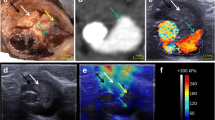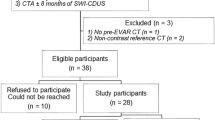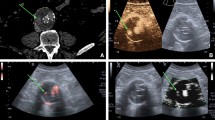Abstract
Objectives
To investigate if shear wave imaging (SWI) can detect endoleaks and characterize thrombus organization in abdominal aortic aneurysms (AAAs) after endovascular aneurysm repair.
Methods
Stent grafts (SGs) were implanted in 18 dogs after surgical creation of type I endoleaks (four AAAs), type II endoleaks (13 AAAs) and no endoleaks (one AAA). Color flow Doppler ultrasonography (DUS) and SWI were performed before SG implantation (baseline), on days 7, 30 and 90 after SG implantation, and on the day of the sacrifice (day 180). Angiography, CT scans and macroscopic tissue sections obtained on day 180 were evaluated for the presence, size and type of endoleaks, and thrombi were characterized as fresh or organized. Endoleak areas in aneurysm sacs were identified on SWI by two readers and compared with their appearance on DUS, CT scans and macroscopic examination. Elasticity moduli were calculated in different regions (endoleaks, and fresh and organized thrombi).
Results
All 17 endoleaks (100 %) were identified by reader 1, whereas 16 of 17 (94 %) were detected by reader 2. Elasticity moduli in endoleaks, and in areas of organized thrombi and fresh thrombi were 0.2 ± 0.4, 90.0 ± 48.2 and 13.6 ± 4.5 kPa, respectively (P < 0.001 between groups). SWI detected endoleaks while DUS (three endoleaks) and CT (one endoleak) did not.
Conclusions
SWI has the potential to detect endoleaks and evaluate thrombus organization based on the measurement of elasticity.
Key points
• SWI has the potential to detect endoleaks in post-EVAR follow-up.
• SWI has the potential to characterize thrombus organization in post-EVAR follow-up.
• SWI may be combined with DUS in post-EVAR surveillance of endoleak.





Similar content being viewed by others
Abbreviations
- AAA:
-
Abdominal aortic aneurysm
- CEUS:
-
Contrast-enhanced ultrasonography
- CI:
-
Confidence interval
- CT:
-
Computed tomography
- DSA:
-
Digital subtraction angiography
- DUS:
-
Color flow Doppler ultrasonography
- EVAR:
-
Endovascular repair
- MRI:
-
Magnetic resonance imaging
- NIVE:
-
Non-invasive vascular elastography
- ROI:
-
Region of interest
- SG:
-
Stent graft
- SWI:
-
Shear wave imaging
- US:
-
Ultrasound
References
Eliason JL, Upchurch GR Jr (2009) Endovascular treatment of aortic aneurysms: state of the art. Curr Treat Options Cardiovasc Med 11(2):136–145
Zhou W, Blay E Jr, Varu V et al (2014) Outcome and clinical significance of delayed endoleaks after endovascular aneurysm repair. J Vasc Surg 59(4):915–920
van Beek SC, Legemate DA, Vahl A et al (2014) External validation of the Endovascular aneurysm repair Risk Assessment model in predicting survival, reinterventions, and endoleaks after endovascular aneurysm repair. J Vasc Surg 59(6):1555–1561.e3
Steingruber IE, Neuhauser B, Seiler R et al (2006) Technical and clinical success of infrarenal endovascular abdominal aortic aneurysm repair: a 10-year single-center experience. Eur J Radiol 59(3):384–392
Brown LC, Brown EA, Greenhalgh RM, Powell JT, Thompson SG (2010) Renal function and abdominal aortic aneurysm (AAA): the impact of different management strategies on long-term renal function in the UK EndoVascular Aneurysm Repair (EVAR) Trials. Ann Surg 251(5):966–975
Noll RE Jr, Tonnessen BH, Mannava K, Money SR, Sternbergh WC 3rd (2007) Long-term postplacement cost after endovascular aneurysm repair. J Vasc Surg 46(1):9–15, discussion 15
White HA, Macdonald S (2010) Estimating risk associated with radiation exposure during follow-up after endovascular aortic repair (EVAR). J Cardiovasc Surg (Torino) 51(1):95–104
Müller-Wille R, Borgmann T, Wohlgemuth WA et al (2014) Dual-energy computed tomography after endovascular aortic aneurysm repair: the role of hard plaque imaging for endoleak detection. Eur Radiol 24(10):2449–2457
AbuRahma AF, Welch CA, Mullins BB, Dyer B (2005) Computed tomography versus color duplex ultrasound for surveillance of abdominal aortic stent-grafts. J Endovasc Ther 12(5):568–573
Giannoni MF, Palombo G, Sbarigia E, Speziale F, Zaccaria A, Fiorani P (2003) Contrast-enhanced ultrasound imaging for aortic stent-graft surveillance. J Endovasc Ther 10:208–217
Ten Bosch JA, Rouwet EV, Peters CT et al (2010) Contrast-enhanced ultrasound versus computed tomographic angiography for surveillance of endovascular abdominal aortic aneurysm repair. J Vasc Interv Radiol 21(5):638–643
Bendick PJ, Zelenock GB, Bove PG, Long GW, Shanley CJ, Brown OW (2003) Duplex ultrasound imaging with an ultrasound contrast agent: the economic alternative to CT angiography for aortic stent graft surveillance. Vasc Endovasc Surg 37:165–170
Karthikesalingam A, Al-Jundi W, Jackson D et al (2012) Systematic review and meta-analysis of duplex ultrasonography, contrast-enhanced ultrasonography or computed tomography for surveillance after endovascular aneurysm repair. Br J Surg 99(11):1514–1523
Abbas A, Hansrani V, Sedgwick N, Ghosh J, McCollum CN (2014) 3D contrast enhanced ultrasound for detecting endoleak following endovascular aneurysm repair (EVAR). Eur J Vasc Endovasc Surg 47(5):487–492
Wilson SR, Greenbaum LD, Goldberg BB (2009) Contrast-enhanced ultrasound: what is the evidence and what are the obstacles? AJR Am J Roentgenol 193:55–60
Sarvazyan AP, Rudenko OV, Swanson SD, Fowlkes JB, Emelianov SY (1998) Shear wave elasticity imaging: a new ultrasonic technology of medical diagnostics. Ultrasound Med Biol 24(9):1419–1435
Gürtler VM, Rjosk-Dendorfer D, Reiser M, Clevert DA (2014) Comparison of contrast-enhanced ultrasound and compression elastography in follow-up after endovascular aortic aneurysm repair. Clin Hemorheol Microcirc 57(2):175–183
Lerner LS (1996) Modern Physics for Scientists and Engineers, Volume 2. Chapter 22: Summing up. Jones & Bartlett, London, p 622
Canadian Council on Animal Care in Science. Available via http://www.ccac.ca/en_/standards/guidelines. Accessed 30 Jul 2016
National Research Council of the National Academies (2011) Guide for the care and use of laboratory animals. National Academies Press, Washington DC, Available via https://grants.nih.gov/grants/olaw/Guide-for-the-Care-and-use-of-laboratory-animals.pdf. Accessed 30 Jul 2016
Lerouge S, Raymond J, Salazkin I et al (2004) Endovascular aortic aneurysm repair with stent-grafts: experimental models can reproduce endoleaks. J Vasc Interv Radiol 15(9):971–979
Soulez G, Lerouge S, Salazkin I, Darsaut T, Oliva VL, Raymond J (2007) Type I and collateral flow in experimental aneurysm models treated with stent-grafts. J Vasc Interv Radiol 18(2):265–272
Salloum E, Bertrand-Grenier A, Lerouge S et al (2016) Abdominal aortic aneurysm: follow-up with noninvasive vascular elastography in a canine model. Radiology 279(2):410–419
Maurice RL, Ohayon J, Frétigny Y, Bertrand M, Soulez G, Cloutier G (2004) Noninvasive vascular elastography: theoretical framework. IEEE Trans Med Imaging 23(2):164–180
Stavropoulos SW, Clark TW, Carpenter JP et al (2005) Use of CT angiography to classify endoleaks after endovascular repair of abdominal aortic aneurysms. J Vasc Interv Radiol 16(5):663–667
Cohen J (1960) A coefficient of agreement for nominal scales. Educ Psychol Meas 20(1):37–46
Gürtler VM, Sommer WH, Meimarakis G et al (2013) A comparison between contrast-enhanced ultrasound imaging and multislice computed tomography in detecting and classifying endoleaks in the follow-up after endovascular aneurysm repair. J Vasc Surg 58(2):340–345
Perini P, Sediri I, Midulla M, Delsart P, Gautier C, Haulon S (2012) Contrast-enhanced ultrasound vs. CT angiography in fenestrated EVAR surveillance: a single-center comparison. J Endovasc Ther 19(5):648–655
Elkouri S, Panneton JM, Andrews JC et al (2004) Computed tomography and ultrasound in follow-up of patients after endovascular repair of abdominal aortic aneurysm. Ann Vasc Surg 18(3):271–279
Risberg B, Delle M, Lönn L, Syk I (2004) Management of aneurysm sac hygroma. J Endovasc Ther 11(2):191–195
Mfoumou E, Tripette J, Blostein M, Cloutier G (2014) Time-dependent hardening of blood clots quantitatively measured in vivo with shear-wave ultrasound imaging in a rabbit model of venous thrombosis. Thromb Res 133(2):265–271
Kulcsár Z, Houdart E, Bonafé A et al (2011) Intra-aneurysmal thrombosis as a possible cause of delayed aneurysm rupture after flow-diversion treatment. AJNR Am J Neuroradiol 32(1):20–25
Ashton JH, Vande Geest JP, Simon BR, Haskett DG (2009) Compressive mechanical properties of the intraluminal thrombus in abdominal aortic aneurysms and fibrin-based thrombus mimics. J Biomech 42(3):197–201
Wang DH, Makaroun M, Webster MW, Vorp DA (2001) Mechanical properties and microstructure of intraluminal thrombus from abdominal aortic aneurysm. J Biomech Eng 123(6):536–539
Gasser TC, Görgülü G, Folkesson M, Swedenborg J (2008) Failure properties of intraluminal thrombus in abdominal aortic aneurysm under static and pulsating mechanical loads. J Vasc Surg 48(1):179–188
Cornelissen SA, van der Laan MJ, Vincken KL et al (2011) Use of multispectral MRI to monitor aneurysm sac contents after endovascular abdominal aortic aneurysm repair. J Endovasc Ther 18(3):274–279
Engellau L, Larsson EM, Albrechtsson U et al (1998) Magnetic resonance imaging and MR angiography of endoluminally treated abdominal aortic aneurysms. Eur J Vasc Endovasc Surg 15(3):212–219
Mori K, Saida T, Sato F et al (2016) Endoleak detection after endovascular aneurysm repair using unenhanced MRI with flow suppression technique: feasibility study in comparison with contrast-enhanced CT. Eur Radiol. doi:10.1007/s00330-016-4315-5
Weigel S, Tombach B, Maintz D et al (2003) Thoracic aortic stent graft: comparison of contrast-enhanced MR angiography and CT angiography in the follow-up: initial results. Eur Radiol 13(7):1628–1634
He CM, Roach MR (1994) The composition and mechanical properties of abdominal aortic aneurysms. J Vasc Surg 20(1):6–13
ClinicalTrials.gov (2013) Abdominal aortic aneurysm follow-up after endovascular repair by non-invasive vascular elastography (AAA-Elasto). ClinicalTrials.gov identifier NCT01907386. National Institutes of Health. Available via https://clinicaltrials.gov/ct2/show/NCT01907386?term=abdominal+aortic+aneurysm&recr=Not+yet+recruiting&rslt=Without&type=Intr&titles=abdominal+aortic+aneurysm+followup+after+endovascular+repair+by+noninvasive+vascular+elastography&cntry1=NA%3ACA&state1=NA%3ACA%3AQC&locn=Montreal&rank=1. Accessed 2 Aug 2016
Acknowledgments
We are grateful to Jocelyn Lavoie, RT, for preparing and organizing the logistics of this project. We thank Michel Gouin, RT, and Gino Potvin, RT, for their work on US and CT acquisition. We also thank the staff of the CRCHUM animal care facility for their expertise in animal experimentation and follow-up.
The scientific guarantor of this publication is Dr. Gilles Soulez, MD, MSc. The authors declare no relationships with any companies, whose products or services may be related to the subject matter of the article. This study received funding by Fonds de Recherche du Québec – Santé (FRQS) (ARQ no. 22951) and the Canadian Institutes of Health Research (MOP no. 115099). G.S. is supported by a National Scientist award from FRQS. A.T. is supported by a Junior 1 Research Award from the FRQS and Fondation de l'association des radiologistes du Québec (no. 26993). Martin Ladouceur, PhD, kindly provided statistical advice. Institutional Review Board approval and written inform consent were not necessary because the study was an animal study. Approval from the institutional animal care committee was obtained. Some study animals or cohorts have been previously reported as part of an investigation of another elastography technique (non-invasive vascular elastography) [23]. The methodology of this project was experimental.
Author information
Authors and Affiliations
Corresponding author
Rights and permissions
About this article
Cite this article
Bertrand-Grenier, A., Lerouge, S., Tang, A. et al. Abdominal aortic aneurysm follow-up by shear wave elasticity imaging after endovascular repair in a canine model. Eur Radiol 27, 2161–2169 (2017). https://doi.org/10.1007/s00330-016-4524-y
Received:
Revised:
Accepted:
Published:
Issue Date:
DOI: https://doi.org/10.1007/s00330-016-4524-y




